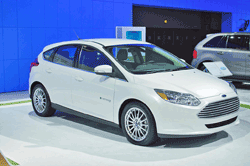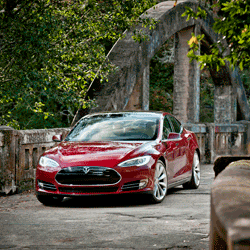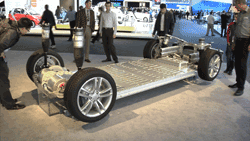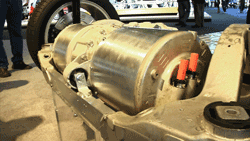
The most expensive version Ford Focus compact sedan costs $22,305, that is, except for the electric version, which costs $39,200. A nice car, the Focus. A real good design. But that’s a lot of money for a 107-kW (143-hp) electric motor, a 23-kWh liquid-cooled lithium-ion battery, and a one-speed automatic transmission. (Wait, how can you have a one-speed transmission — either automatic or manual?) Let’s look into the motors used by a couple of the available electrics.
The Focus Electric is a full electric vehicle. If you get an optional 240-V charging station ($1,500) installed in your garage, you’ll get a full charge in 3 to 4 hours. The car has a 76-mile range on a charge and a top speed of 84 mph. The motor gives 181 lb-ft of torque.
The Ford Focus Electric uses a 107 kW (143 HP) electric motor.
The Tesla model S all electric family sedan is due out in June. It uses a 40-, 60-, or 85-kWh battery pack and features 160-, 230-, or 300-mile range. We don’t know the kW or horsepower of the motor, but the base model does 0 to 60 mph in 6.5 s and will do 110 mph, while the performance model said to do 60 mph in just 4.4 s. The heart of the Tesla S is its three-phase, four-pole induction motor, which weighs just 70 lbs (I’ve also heard 115 lbs).
The Model S will run you $49,900 to $97,900 so you better see about that second mortgage.
While most all electric vehicles around today use a permanent magnet ac motor, the Tesla has an induction ac motor. Induction motors are by far the most common type in use today in blowers, elevators, refrigerators, and industrial controls. Most of those use an aluminum rotor, but for their high-performance application Tesla uses a copper rotor. Copper has about half the resistivity of aluminum — both electrical and thermal.
Fukuta Electric & Machinery, in Taiwan, collaborated with Tesla Motors on the development of an induction motor for Tesla’s earlier electric Roadster. It used a copper rotor, as does the Tesla Model S. The motor is produced in Tesla’s Fremont, CA, factory.
The Tesla S chassis includes batteries integrated into the frame.
I spoke with Malcolm Burwell of the International Copper Association (www.coppermotor.com and http://copperalliance.org) in Arlington, MA, about motor design. Malcolm pointed out that PM ac motors use rare-earth materials for magnets and the price of those materials has sky-rocketed in the past few years — going up 4X in just the last two years. He says materials for a 50-kW PM motor might cost $700, whereas materials for an induction motor of the same power might be only $150.
The Model S has a single motor driving the rear wheels. The second unit here is the gearbox.
The PM motor has a broader rpm range with high-efficiency operation and it is efficient at lower rpms — around 95% efficiency is possible from roughly 1,400 to 3,600 rpm, where the induction type might be 92% to 95% from 2,300 to 4,200 rpm.
One should understand that electric motor design is craft and/or an art and is not as straightforward as some would like to think. So it often takes years to refine and optimize a motor design. And, then you have the drive electronics, which is another significant design variable in efficiency, in weight, and in cost.
The latest power devices can improve the inverter efficiency considerably. In the past few years, the cost of the control electronics has come down significantly because of a much higher level of integration of semiconductor and other components. Also, high-quality software is now an essential ingredient to a good motor drive design.
|
Motor Type |
Battery Type |
Vehicle Weight |
|
|
Ford Focus |
107-kW PM electric motor |
23-kWh battery |
3,642 lbs |
|
Tesla Model S |
Kilowatts unknown 4-pole AC induction motor |
40-, 60-, or 85- KWh lithium-ion lithium-ion |
3,825 lbs |
|
Toyota Prius |
60-kW AC PM motor + 98 HP gas |
27 KWh Ni-MH |
3,042 lbs |
|
Nissan |
80-kW AC PM electric motor |
24 kWh lithium-ion |
3,360 lbs |
|
Chevrolet |
111-kW AC PM drive unit + 84 HP gas |
16-kWh lithium-ion |
3,750 lbs |
All of the vehicles in the table are in production except the Tesla, which will be available in June.
Of course, there are many other full electric and hybrid electric cars in design by most every automobile manufacturer. When looking at the specifications for various vehicles be careful with the motor kW or horsepower ratings. Marketers tend to use peak values instead of average and the way both peak and average values are measured can vary considerably.
Will motor costs come down in the next few years? Yes, as production volumes increase there will be cost reductions, but probably not great enough to significantly impact electric car pricing. But, combined with some new battery technology that cuts costs we might see a very competitively priced vehicle in the next five years or so — or certainly more-so than now. Most all car manufactures are designing and manufacturing their own motors, as car people want to keep major component in house. We will try to keep a sharp eye on these motor designs, although the manufacturers are not always willing to share details with us.
To learn how to design and develop motor control applications with NXP MagniV MCUs using model-based design, register for the free webinar, sponsored by NXP
Advertisement
Learn more about Electronic Products Magazine





